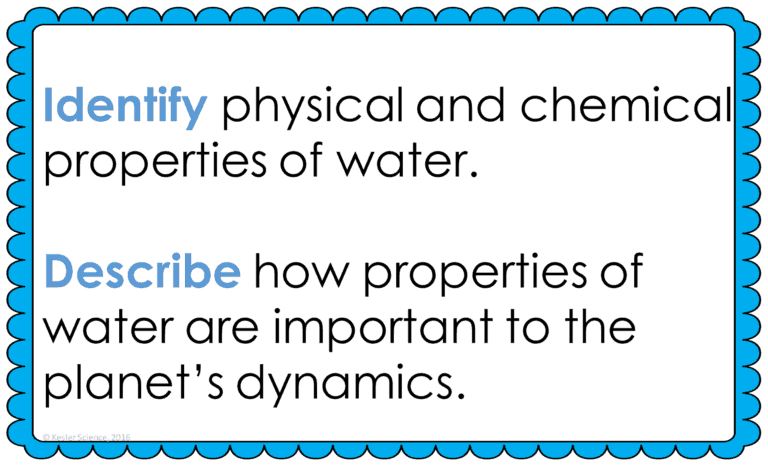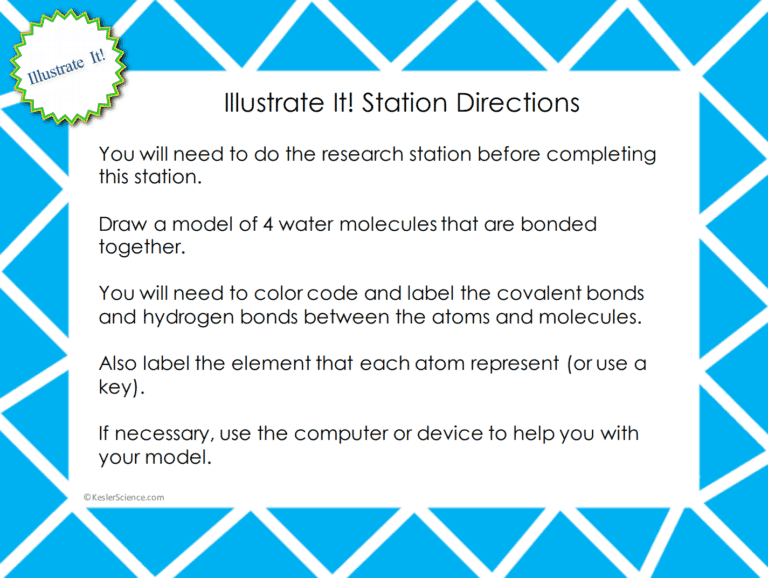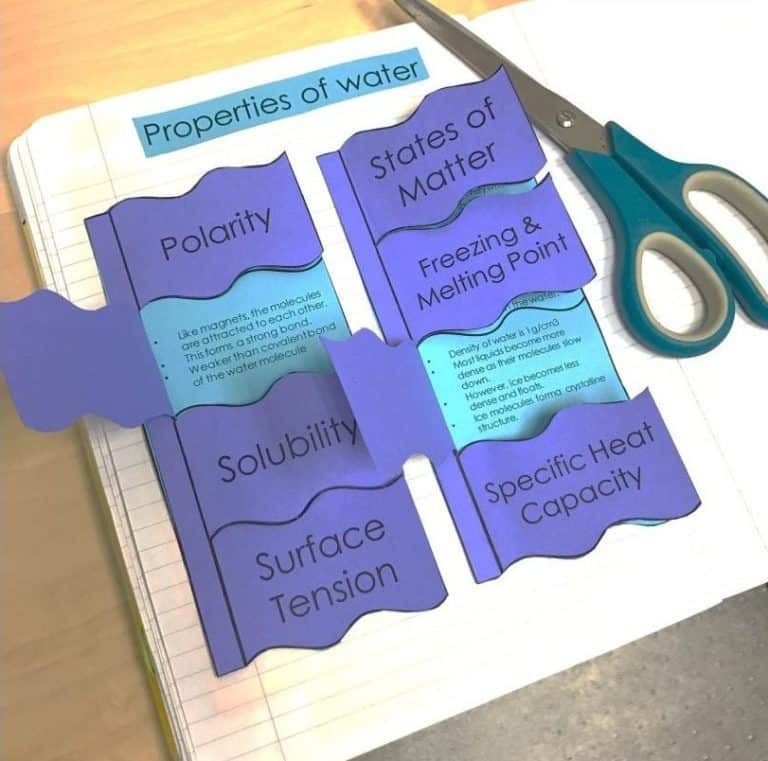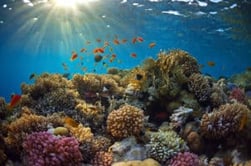Properties of Water Lesson Plan - A Complete Science Lesson Using the 5E Method of Instruction
At the end of this properties of water lesson plan, students will be able to identify physical and chemical properties of water and describe how properties of water are important to the planet’s dynamic. Each lesson is designed using the 5E method of instruction to ensure maximum comprehension by the students.
The following post will walk you through each of the steps and activities from the properties of water lesson plan.
ENGAGEMENT
Objective Introduction
At the beginning of the lesson, the class will do a Think-Pair-Share to discuss the objective.
Class Activity
- Write these words on the board:
- Physical Properties
- Chemical Properties
- Explain to students they will be making a chart/table/picture note (their choice) of the properties of water after they have viewed the video.
- Show Video – Properties of Water
Student Activity
- Have them break up into small groups (your choice on size).
- In each group brainstorm what needs to be in their chart.
- Construct their chart/table/picture notes.
- Have one or two groups present their final product.

The teacher will help to clear any misconceptions about properties of water. Some major misconceptions are students think objects float in water because they are lighter than water. Not always – think surface tension. Also, students think ice molecules are colder than water molecules. Really ice molecules have less kinetic energy than water molecules.
Estimated Class Time for the Engagement: 20-30 minutes
EXPLORATION
This student-centered station lab is set up so students can begin to explore the properties of water. Four of the stations are considered input stations where students are learning new information about the properties of water and four of the stations are output stations where students will be demonstrating their mastery of the input stations. Each of the stations is differentiated to challenge students using a different learning style. You can read more about how I set up the station labs here.
EXPLORE IT!
Students will be working in pairs to better understand what it means when water is described as having surface tension. Students will follow the directions on the task cards as they conduct a mini lab about surface tension with a water dropper and a penny.
WATCH IT!
At this station, students will be watching a seven-minute video explaining the properties of water. Students will then answer questions related to the video and record their answers on their lab station sheet. For example: Describe what a hydrogen bond is. What is surface tension? List two examples from the video of how the properties of water are important to life on Earth.
RESEARCH IT!
The research station will allow students to interact with a simulation that allows them to create water molecules. It will teach the students about polarity and how molecules can be fused by chemical bonding. Students will then be directed to answer a few questions based on the research they conducted.
READ IT!
This station will provide students with a one page reading about capillary action. In the reading, students will discover what capillary action is and why it is important in our everyday lives. There are 4 follow-up questions that the students will answer to show reading comprehension of the subject.
ASSESS IT!
The assess it station is where students will go to prove mastery over the concepts they learned in the lab. The questions are set up in a standardized format with multiple choice answers. Some questions include: Which best illustrates the electrical charge of a water molecule? Which property of water is responsible for capillary action? Why is a good example of the property of water called surface tension? Which answer best describes cohesion?
WRITE IT!
Students who can answer open-ended questions about the lab truly understand the concepts that are being taught. At this station the students will be answering three task cards: Describe what polarity means in terms of being a property of water. What is evaporation and how does it contribute to the survival of species? What properties of water allows the organisms to survive underneath the ice?
ILLUSTRATE IT!
Your visual students will love this station. Students will need to have completed the research station portion first because students will need to draw a model showing 4 water molecules bonded together. Students may use a computer device for reference.

ORGANIZE IT!
The organize it station allows your students to place cards containing the definitions to the correct vocabulary word that it is describing.

Estimated Class Time for the Exploration: 1-2, 45 minute class periods
EXPLANATION
The explanation activities will become much more engaging for the class once they have completed the exploration station lab. During the explanation piece, the teacher will be clearing up any misconceptions about the properties of water with an interactive PowerPoint, anchor charts, and interactive notebook activities. The properties of water lesson includes a PowerPoint with activities scattered throughout to keep the students engaged.
The students will also be interacting with their journals using INB templates for properties of water. Each INB activity is designed to help students compartmentalize information for a greater understanding of the concept. The properties of water INB template allow students to focus their notes on learning the vocabulary and their definitions.

Estimated Class Time for the Exploration: 2-3, 45 minute class periods
ELABORATION
The elaboration section of the 5E method of instruction is intended to give students choice on how they can prove mastery of the concept. When students are given choice the ‘buy-in’ is much greater than when the teacher tells them the project they will have to create. The elaboration project will allow students to create a presentation to teach about the properties of water.
Estimated Class Time for the Elaboration: 2-3, 45 minute class periods (can also be used as an at-home project)
EVALUATION
The final piece of the 5E model is to evaluate student comprehension. Included in every 5E lesson is a homework assignment, assessment, and modified assessment. Research has shown that homework needs to be meaningful and applicable to real-world activities in order to be effective. When possible, I like to give open-ended assessments to truly gauge the student’s comprehension.
Estimated Class Time for the Elaboration: 1, 45 minute class period
DOWNLOAD THE FULL LESSON NOW
The full lesson is available for download from the Kesler Science Store. Save yourself a ton of time and grab it now.
Download Over $100 in FREE Resources
For Middle School Science
Simply create a login below and gain immediate access to a selection of our Kesler Science product line worth $100 - for FREE. There's a full version of every product type! You'll also join tens of thousands of middle school science teachers who receive timely tips and strategies straight to their inbox.





